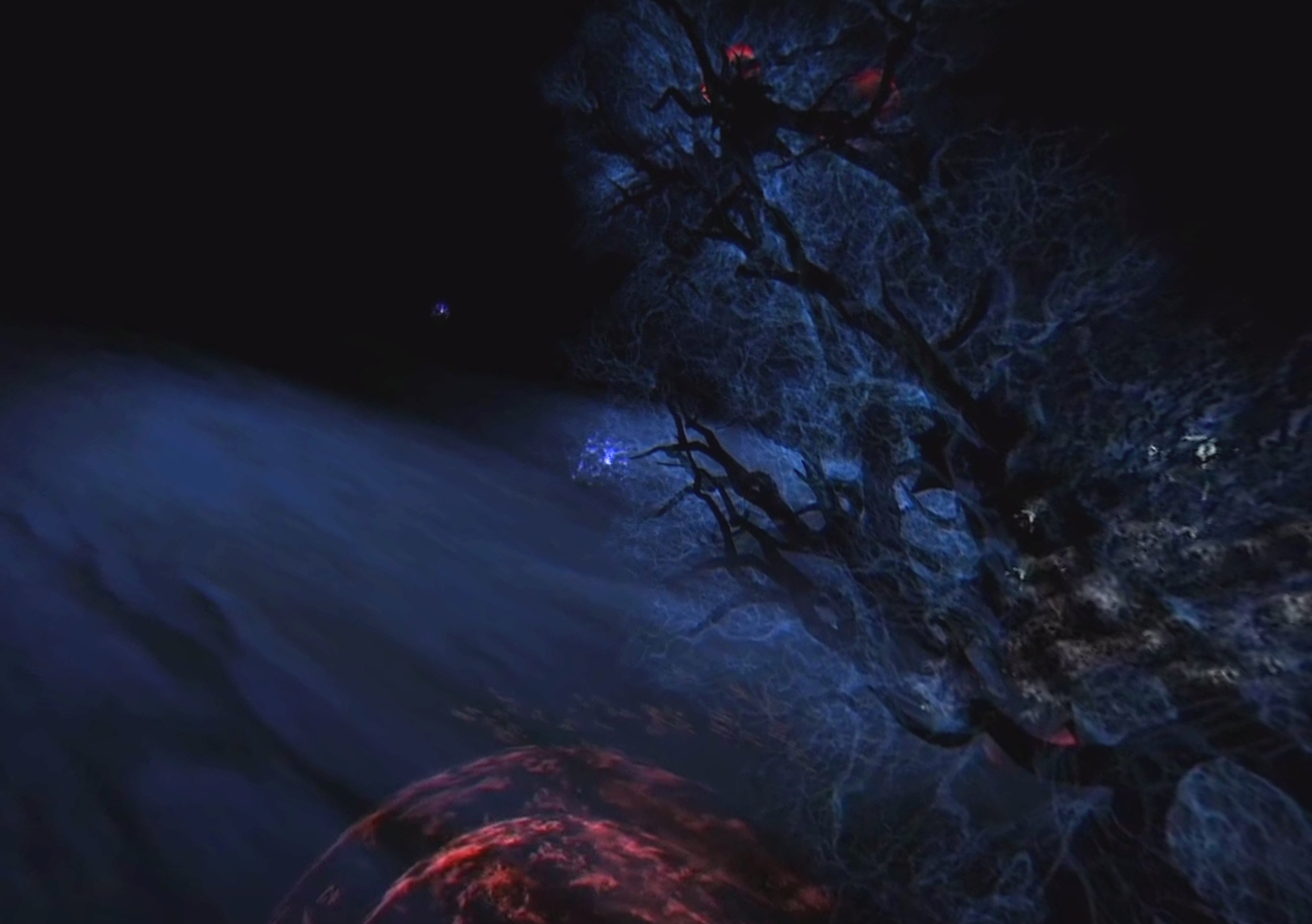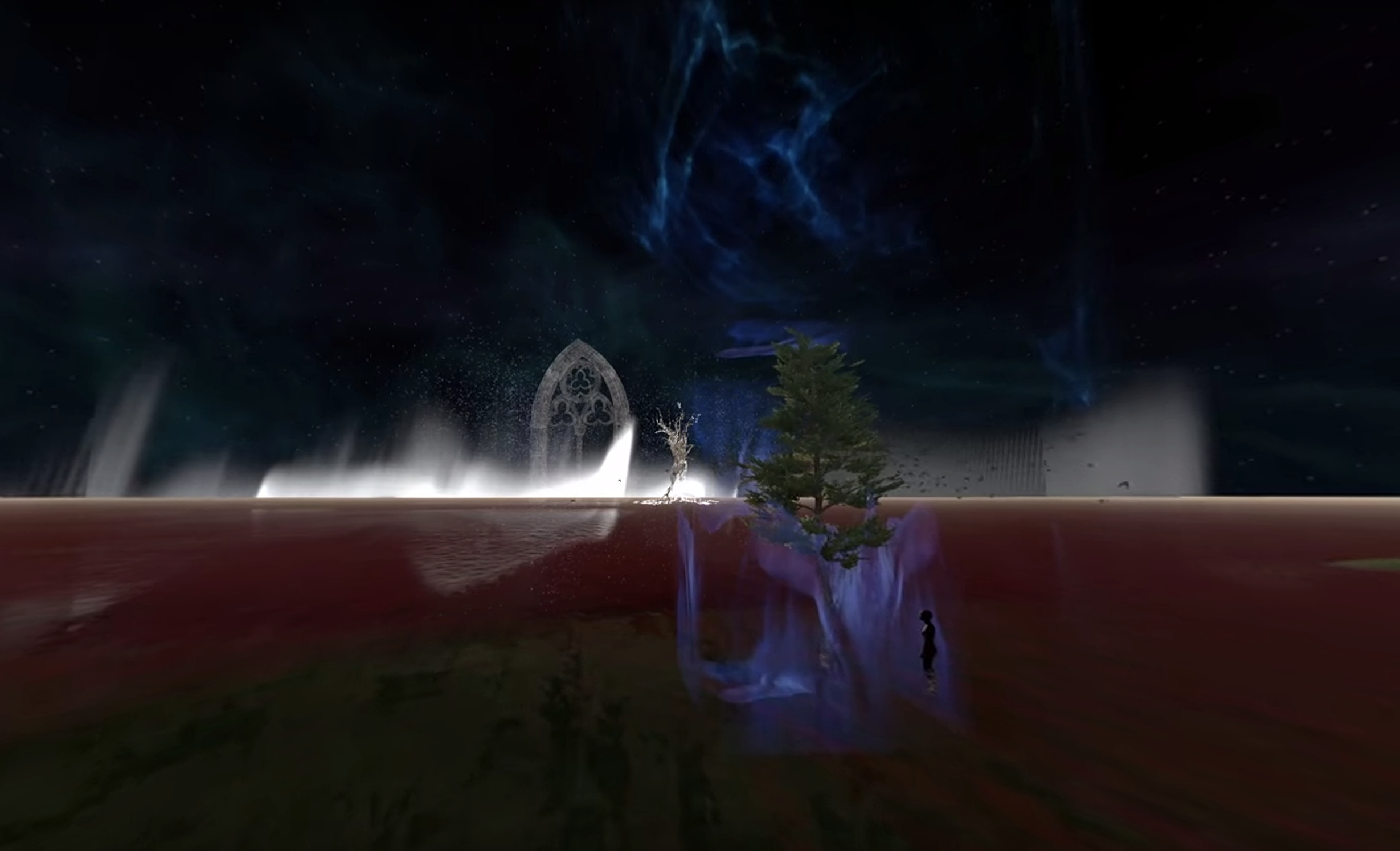The VR Poetry Project
Le projet de poèmes en réalité virtuelle
Virtual Reality and Poetry/Réalité virtuelle et poésie


For William Gibson, author of Neuromancer, today’s world can be summarized with two terms: terror and ecstasy.
Using VR and poetry, I want to explore today’s human/machine continent, and understand what lies at the heart of this feeling of terror and ecstasy.
I also want to explore whether a digital specific language can be found, one that opens the door to a better exploration, analysis and understanding of the human/machine continent.
In fact, my goal is to find the equivalent of montage in digital art. What is montage when one creates digital worlds?
Let me be a bit provocative and suggest that poetry is not fundamentally about the written word.
Poetry is a territory.
Poetry is a territory of emotions, a territory of the metaphysical, where we explore large, important questions about what it means to be human
But poetry is not the only territory.
Technology, finance, politics create territories.
The poetic territory has its own specificities however: Learning and inquiétude (disquiet).
The poetic realm allows one to learn complex emotional/social/metaphysical situations.
But poetry also adds ‘inquiétude.’
What is inquiétude? It’s the tension between Fate and Faith, the tension between life and death; love and solitude; beauty and terror.
In a great work of art, the inquiétude takes a life of its own. It emerges out of the layers of meaning and structure (syntax, colours, rhythm, etc.).
But the toolboxes between traditional poetry and VR poetry are not the same.
Human language is an algorithm. Writing is coding. Coding for meaning, coding for intention, coding for action.
But working with a program is not, essentially, working with language. It is working with a co-creator.
We don’t always know what software will render, how it will react, how it will display.
The poet in virtual worlds works and creates with the ‘machine’.
But the machine has ‘will’, abilities, ‘intentions,’ directions (it ‘wants’ to do something). This is what code is. It allows, permits, decides.
This co-creation gives birth to co-created disquiet.
When one uses software, one gives rise to a new disquiet: the tension between faith, fate and progress (for a lack of better word).
Progress is machine’s need to control the world, make it a perfect place for the machine ecosystem.
Using software and virtual worlds, we can now have access to new territories of emotions, of disquiet and of learning that are specific to the human/machine world we live in.
But for that to happen, we have to use a new approach: the montage of VR.
What would be the basis of montage in VR?
While Lev Manovich’s principles of New Media creation are very useful, I have learned that other fundamental principles also seem to apply.
When one works and co-create virtual artworks, one should keep the following in mind:
VR art is like experimenting on a living organism. One tries to assemble many different modules that react in their own specific, sometimes uncontrollable, ways.
Thus, while creating in the digital realm one should

Because
VR poetry tell us something about the metaphysics of the human/machine world.


Pour William Gibson, auteur de Neuromancer, le monde d'aujourd'hui peut se résumer en deux termes: la terreur et le ravissement.
En utilisant la réalité virtuelle et la poésie, je veux explorer le continent humain/machine d'aujourd'hui et comprendre ce qui se trouve au cœur de ce sentiment de terreur et de ravissement.
Je tente aussi de trouver un langage numérique spécifique au continent humain/machine, un langage qui ouvrirait la porte à une meilleure exploration, analyse et compréhension de ce continent.
Laissez-moi être un peu provocateur et suggérer que la poésie est un territoire.
Un territoire d'émotions, un territoire de la métaphysique, où nous explorons de grandes questions sur ce que signifie être humain.
Mais la poésie n'est pas le seul territoire.
La technologie, la finance, la politique créent aussi des territoires.
Le territoire poétique a cependant ses propres spécificités : L’apprentissage et l’inquiétude.
Le monde poétique permet d’explorer puis de comprendre des situations émotionnelles, sociales et psychologiques complexes. Il permet, en fait, d’explorer des questions métaphysiques complexes.
Mais la poésie est aussi, et surtout, un hymne à l’inquiétude.
Qu'est-ce que l'inquiétude? C'est la tension entre le Destin et la Foi (la foi en la vie, l’existence, le libre-arbitre). L’inquiétude émerge de la tension entre la vie et la mort, l'amour et la solitude, la beauté et la terreur.
Mais créer une œuvre poétique en réalité virtuelle implique une posture et une approche différentes. Car le logiciel et son code ne sont pas simplement des langages numériques. Un logiciel co-crée avec l’humain.
Un logiciel cherche à ‘faire’ des choses, il possède sa propre ‘volonté’, ses propres capacités, ses intentions. Le code permet, refuse, décide.
Cette volonté du logiciel transforme radicalement le langage humain, le propos poétique.
Créer un poème dans un monde virtuel implique une co-création: celle de l’humain et de la machine.
Cette co-création donne naissance à une nouvelle inquiétude: celle de la tension entre la foi, le destin et le progrès (faute d'un meilleur mot).
Par progrès, j’entends la ‘volonté’ de la machine de transformer le monde afin d’atteindre les buts qui lui ont été programmés.
En utilisant des logiciels et des mondes virtuels, nous pouvons maintenant avoir accès à de nouveaux territoires d'émotions, d'inquiétudes et d'apprentissage spécifiques au monde humain/machine dans lequel nous vivons.
Mais pour cela, nous devons utiliser une nouvelle approche, un langage spécifique aux mondes virtuels, un langage qui émerge de la fusion entre le langage humain et le langage machine.
Quelle serait la base de ce langage ?
Bien que les principes de la création en nouveaux médias de Lev Manovich soient très utiles, je suggère ici que d'autres principes fondamentaux semblent également s'appliquer.
Il faut comprendre que la création en réalité virtuelle ressemble à l’expérimentation sur des êtres vivants, car le logiciel ‘respire’, change, se modifie, est fluide. Et est souvent, du moins en partie, incontrôlable.
Ainsi, lorsqu’il y a création en RV, il est important
de ne pas imposer, mais de déclencher;
de ne pas forcer, mais de semer: semer une esthétique, des émotions, une texture, des couleurs, du rythme;
de comprendre que le canevas utilisé en est un fait de strates qui interagissent;
d’utiliser le ‘pinceau’ que sont données, chiffres et mesures;
de raconter par l’intermédiaire d’un volume, d’un espace, du temps et du mouvement.

Pourquoi devrait-on créer de la poésie en réalité virtuelle? Pourquoi explorer la co-création humain/machine?
Car
les limites, les capacités, la volonté, la syntaxe des logiciels et des machines ouvrent la porte à une compréhension du monde dans lequel nous vivons actuellement;
l’ouverture de cette porte nous permet d’entrevoir une partie de la signification globale du continent humain/machine;
nous pouvons alors penser à et expérimenter sur ce que signifie
voir nos émotions limitées, enrichies mais aussi recréées par des machines;
voir notre humanité redessinée par les machines. Et les machines redéfinies par l’humain.
La poésie en réalité virtuelle explore la métaphysique du monde humain/machine et nous en donne des pistes des compréhension.